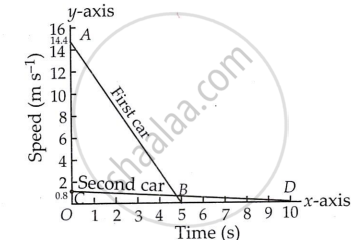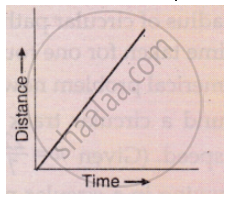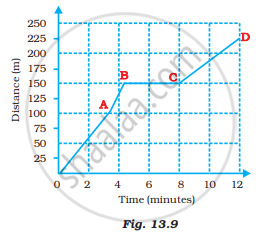Advertisements
Advertisements
Question
A driver of a car travelling at 52 km h−1 applies the brakes and accelerates uniformly in the opposite direction. The car stops in 5 s. Another driver going at 3 km h−1 in another car applies his brakes slowly and stops in 10 s. On the same graph paper, plot the speed versus time graphs for the two cars. Which of the two cars travelled farther after the brakes were applied?
Solution
The data given in this numerical problem are in different units. So, we should first convert km h-1 unit into m s-1 unit.
For first car:
Initial velocity u = 52 km h-1
= `(52 "km")/(1 "h")`
= `(52 xx 1000 "m")/(1 xx 3600 "s")`
= 14.4 s-1
Final velocity, v = 0 km h-1 = 0.0 m s-1
Time taken, t = 5s
For second car:
Initial velocity, u = 3 km h-1
= `(3 "km")/(1"h")`
= `(3 xx 1000 "m")/(1 xx 3600 "s")`
= 0.8 ms-1
Final velocity, v = 0 km h-1 = 0.0 m s-1
Time taken, t = 10s

The area under a moving body's speed-time graph indicates the distance it has traveled.
So, Distance travelled by the first car = Area of the triangle AOB
= `1/2 xx "OB" xx "AO"`
= `1/2 xx 14.4` ms-1 × 5s
= `1/2 xx 14.4 xx 5 "m"`
= 36 m
Similarly, distance travelled by the second car = area of triangle COD.
= `1/2 xx "OD" xx "CO"`
= `1/2 xx 0.83 m s^-1 xx 10 s`
= `1/2 xx 0.83 xx 10 "m"`
= 4.1 m
Thus, the second car travels 4.1 m and the first car travels 36 m before coming to rest.
So, the first car travelled farther after the brakes were applied.
APPEARS IN
RELATED QUESTIONS
What is the nature of the distance-time graphs for uniform and non-uniform motion of an object?
What can you say about the motion of an object whose distance-time graph is a straight line parallel to the time axis?
What does the slope of a distance-time graph indicate ?
What conclusion can you draw about the speed of a body from the following distance-time graph ?

Name the two quantities, the slope of whose graph give speed .
A body moves along a straight road with a speed of 20 m/s and has a uniform acceleration of 5 m/s2. What will be its speed after 2 s?
Boojho goes to the football ground to play football. The distance-time graph of his journey from his home to the ground is given in Figure 13.9.

(a) What does the graph between points B and C indicate about the motion of Boojho?
(b) Is the motion between 0 to 4 minutes uniform or nonuniform?
(c) What is his speed between 8 and 12 minutes of his journey?
The area under velocity time graph represents ______.
The slope of the distance-time curve is steeper/greater is the ______.
The slope of the distance-time graph indicates the speed.
